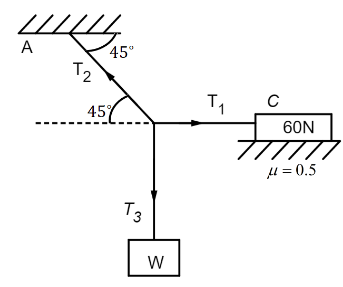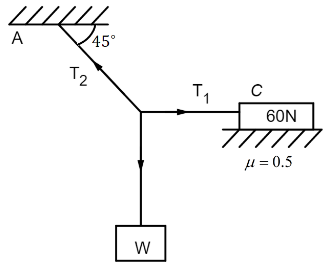
Answer
395.1k+ views
Hint: Any block placed on a rough surface (having some coefficient of friction) moves when the force applied on it is greater than limiting static friction (or limiting friction) whose value is equals to the normal force times the coefficient of friction.
Formula used:
The mathematical expression for static friction is given by,
\[f\, = \,\mu N\]
where $f$ is the frictional force and $N$ is the normal force.
Complete step by step answer:
Let’s analyse the blocks first

Block C: Forces acting on Block C are:
-Normal reaction force from surface on which it is kept (N)
-Tension force (${T_1}$)
-Its weight (60N)
-Static frictional force (f)

As block C is in equilibrium
\[\therefore \,\,\sum {{F_x}\, = \,0\,} \]
\[ \Rightarrow \,f - \,{T_{1\,}}\, = \,0\]
Hence \[f = \,\,{T_{1\,}}\] ……………..…………………\[(i)\]
also \[\sum {{F_y}\, = \,0\,} \]
\[ \Rightarrow \,\,N\, - \,\,60\, = \,0\] or \[N\, = \,\,60\] …………..\[(ii)\]
The frictional force on block C:
\[f\, = \,\mu N\, = \,0.5 \times \,60\, = \,30N\]………\[(iii)\] [using \[(ii)\]]
Using equation \[(i)\] and \[(iii)\] we get \[{T_1}\,\, = \,\,30N\]………….\[(iv)\]
Block B: Forces acting on Block B are:
Tension force (${T_3}$)

Its weight (W). As block B is in equilibrium
\[\therefore \,\sum {{F_y}\, = \,0\,} \] \[ \Rightarrow \,\,{T_{3\,}}\, - \,\,W\, = \,0\]
Hence, \[{T_{3\,}}\, = \,\,W\] ………………………………..\[(v)\]
As the junction P is in equilibrium so at point P
\[\sum {{F_x}\, = \,0\,} \]
\[\therefore \,\,{T_1}\, = \,{T_2} \times \dfrac{1}{{\sqrt 2 }}\]……………..\[(vi)\]
\[\sum {{F_y}\, = \,0\,} \]
\[\therefore \,{T_3}\, = \,\,{T_2}\, \times \dfrac{1}{{\sqrt 2 }}\]…………….\[(vii)\]
Now using equation \[(vi)\]and\[(iv)\]we get
\[{T_1}\, = \,{T_2} \times \dfrac{1}{{\sqrt 2 }}\]
\[ \Rightarrow \,{T_2} = \,\sqrt 2 {T_1}\,\]
\[\therefore \,\,{T_2}\,\, = \,30\sqrt 2 \,N\]……………\[(viii)\]
Finally, using equation \[(v)\],\[(vii)\] and \[(viii)\]
\[{T_3}\, = \,\,30\sqrt 2 \, \times \dfrac{1}{{\sqrt 2 }}\, = \,30N\] and \[{T_{3\,}}\, = \,\,W\]
Hence \[W\,\, = \,\,30\,Newtons\].
Note: If a block is at rest and keeps on resting on applying force then applied force is equal to the frictional force on the block as net force on the block = 0 in the condition of equilibrium. A body remains at rest if no external force is applied to it.
Formula used:
The mathematical expression for static friction is given by,
\[f\, = \,\mu N\]
where $f$ is the frictional force and $N$ is the normal force.
Complete step by step answer:
Let’s analyse the blocks first

Block C: Forces acting on Block C are:
-Normal reaction force from surface on which it is kept (N)
-Tension force (${T_1}$)
-Its weight (60N)
-Static frictional force (f)

As block C is in equilibrium
\[\therefore \,\,\sum {{F_x}\, = \,0\,} \]
\[ \Rightarrow \,f - \,{T_{1\,}}\, = \,0\]
Hence \[f = \,\,{T_{1\,}}\] ……………..…………………\[(i)\]
also \[\sum {{F_y}\, = \,0\,} \]
\[ \Rightarrow \,\,N\, - \,\,60\, = \,0\] or \[N\, = \,\,60\] …………..\[(ii)\]
The frictional force on block C:
\[f\, = \,\mu N\, = \,0.5 \times \,60\, = \,30N\]………\[(iii)\] [using \[(ii)\]]
Using equation \[(i)\] and \[(iii)\] we get \[{T_1}\,\, = \,\,30N\]………….\[(iv)\]
Block B: Forces acting on Block B are:
Tension force (${T_3}$)

Its weight (W). As block B is in equilibrium
\[\therefore \,\sum {{F_y}\, = \,0\,} \] \[ \Rightarrow \,\,{T_{3\,}}\, - \,\,W\, = \,0\]
Hence, \[{T_{3\,}}\, = \,\,W\] ………………………………..\[(v)\]
As the junction P is in equilibrium so at point P
\[\sum {{F_x}\, = \,0\,} \]
\[\therefore \,\,{T_1}\, = \,{T_2} \times \dfrac{1}{{\sqrt 2 }}\]……………..\[(vi)\]
\[\sum {{F_y}\, = \,0\,} \]
\[\therefore \,{T_3}\, = \,\,{T_2}\, \times \dfrac{1}{{\sqrt 2 }}\]…………….\[(vii)\]
Now using equation \[(vi)\]and\[(iv)\]we get
\[{T_1}\, = \,{T_2} \times \dfrac{1}{{\sqrt 2 }}\]
\[ \Rightarrow \,{T_2} = \,\sqrt 2 {T_1}\,\]
\[\therefore \,\,{T_2}\,\, = \,30\sqrt 2 \,N\]……………\[(viii)\]
Finally, using equation \[(v)\],\[(vii)\] and \[(viii)\]
\[{T_3}\, = \,\,30\sqrt 2 \, \times \dfrac{1}{{\sqrt 2 }}\, = \,30N\] and \[{T_{3\,}}\, = \,\,W\]
Hence \[W\,\, = \,\,30\,Newtons\].
Note: If a block is at rest and keeps on resting on applying force then applied force is equal to the frictional force on the block as net force on the block = 0 in the condition of equilibrium. A body remains at rest if no external force is applied to it.
Recently Updated Pages
Fill in the blanks with suitable prepositions Break class 10 english CBSE

Fill in the blanks with suitable articles Tribune is class 10 english CBSE

Rearrange the following words and phrases to form a class 10 english CBSE

Select the opposite of the given word Permit aGive class 10 english CBSE

Fill in the blank with the most appropriate option class 10 english CBSE

Some places have oneline notices Which option is a class 10 english CBSE

Trending doubts
Fill the blanks with the suitable prepositions 1 The class 9 english CBSE

How do you graph the function fx 4x class 9 maths CBSE

When was Karauli Praja Mandal established 11934 21936 class 10 social science CBSE

Which are the Top 10 Largest Countries of the World?

What is the definite integral of zero a constant b class 12 maths CBSE

Why is steel more elastic than rubber class 11 physics CBSE

Distinguish between the following Ferrous and nonferrous class 9 social science CBSE

The Equation xxx + 2 is Satisfied when x is Equal to Class 10 Maths

Differentiate between homogeneous and heterogeneous class 12 chemistry CBSE





